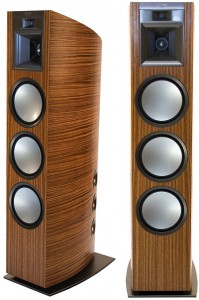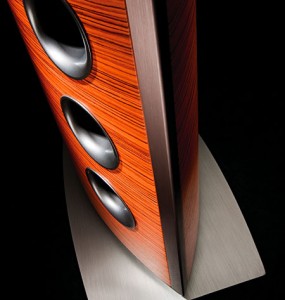It ain’t the stuff you don’t know that trips you up, it’s the stuff you know that ain’t so. When, at the 2007 CEDIA Expo, I encountered Klipsch’s startlingly new Palladium P-39F loudspeaker ($20,000/pair), I was impressed by its looks. Tall (56″), as beautifully contoured as the prow of a canoe, and clad in striking zebra-stripe plywood, the P-39F is possibly the best-looking speaker Klipsch has ever made.
The Klipsch rep, too, was enthusiastic: “This is a loudspeaker that PWK would have approved of!” (Yes, seven years after the death of Paul W. Klipsch, employees still refer to the founder of Klipsch Audio Technologies as PWK—and why not? Most of them have worked there for so long that they knew PWK or were hired by him.)
“How so?” asked WP.
“Obviously, the midrange and tweeter are horn-loaded, but the P-39Fs are efficient, have low distortion, and controlled directivity—all goals that Paul Klipsch sought in every loudspeaker he ever designed. We kept those goals forefront in designing the Palladium line, and we went to DesignworksUSA for the industrial design of the speaker itself, although we developed all of the drivers in-house.”
I ran my hand along the curved flank of one P-39F, admiring its fit’n’finish. Sensing weakness, the rep moved in for the kill. “Maybe you’d like to review them.”
“No offense, but I don’t really like horn speakers,” I said.
As if I’d ever actually lived with a pair. I’d sold Klipsch speakers back when I was an audio salesman, but mostly two-way monitors—they were my fallback model when customers wanted more bass. I’d never spent much time with the “heritage” trio of Cornwall, La Scala, and Klipschorn—my loss, I now suspect.
In the late 1990s and early 2000s, I listened to many large, “retro” horns designed to complement single-ended-triode amplifiers, and I just didn’t cotton to ’em. The bass frequently seemed completely disconnected from the mids and highs—and, in at least one example I heard at a Stereophile Home Entertainment Show, the outputs of the individual drivers didn’t cohere until I was sitting about 30′ away. Granted, I also heard many contemporary dynamic and electrostatic loudspeakers that didn’t do it for me during those years, but I didn’t dismiss those types of speakers out of hand—just horns.
The machinations of time and tide—not to mention an enthusiastic phone call from CNET’s audio blogger Steve Guttenberg, who was rendered almost speechless by the P-39F—conspired to put a pair in my listening room, where indeed I did review them.
The horn, the horn, the lusty horn
The Palladium P-39F is a three-way loudspeaker with a fourth-order crossover. The cones of its three 9″ woofers are constructed from an outer aluminum skin bonded to a Rohacell core, this in turn bonded to Kevlar. The result is a rigid but lightweight diaphragm. Each woofer’s basket is cast aluminum, and its 1.5″-diameter voice-coil is wound from flat copper-clad aluminum wire. Three different neodymium magnets make up the drive system.
The mid-frequency driver is front-loaded with a modified Tractrix horn with a 4:1 high-compression phase plug in its center. The 4.5″ inverted-dome driver is a first for Klipsch—although the company does credit PWK’s famous dictum “The midrange is where we live.” The midrange is claimed to have a raw sensitivity of 110dB. Like the woofers, the midrange driver uses three magnets (the primary magnet uses the other two to stabilize its output). The midrange driver is housed in its own tuned, sealed enclosure within the P-39F’s shell.
The tweeter is also front-loaded with a Tractrix horn, this one with a 10:1 compression phase plug and a 0.75″ dome diaphragm of titanium. The space behind the driver is a resistively damped tube. Klipsch says that the design of the phase plug “extends the upper frequency of the driver by 10kHz,” which is said to have the salubrious effect of eliminating standing waves in the high-pressure layer between plug and driver.
The fourth-order crossover is built on two printed circuit boards mounted to the bottom plate of the speakers with isolation grommets. The parts quality is said to be superb: air-core conductors, polypropylene caps, ultra-low-inductance resistors, etc. The woofers cross over to the mids at 500Hz, the mids cruise from 500Hz to 3.2kHz, and Klipsch claims the tweeter goes from 3.2 to 30kHz!
Then there’s that scrumptious cabinet. It has no parallel surfaces, and curves continuously from its tapered baffle to pointed rear spine. The cabinet—made of compressed laminated plywood, MDF, and particleboard—has an average thickness of 1″, although the baffle is thicker and, where the woofers are mounted, is reinforced with steel. The cabinet’s interior is extensively braced. Each speaker sits atop a high-mass machined metal baseplate tapped for spiked feet. Mounted low on one side of the P-39F are three flared port tubes—the look is old-school Pontiac. Access to the triwired speaker terminals is from under the baseplate, a discovery that elicited much swearing on the part of John Atkinson.
His tunes were frozen up in the horn
Other than the inconvenience of wiring the P-39Fs with audiophile-quality hawsers, setup was a snap. I could have used just about any amp in the house to drive the Palladiums’ 95dB sensitivity, but the VTL MB-450 IIs were already on the amp stands. All I had to do was switch to the VTLs’ triode mode—I sure didn’t need all that pentode power.
I ended up placing the speakers 45″ from the front wall and 32″ from the sidewalls, toed in very slightly. Just an inch under 13′ from my sweet spot, the P-39Fs “clicked” with my room as have very few loudspeakers, even far more expensive ones.
Sugar in the gourd and honey in the horn
Whatever it was I was expecting from a pair of horn speakers, what I got from the Palladium P-39Fs was sound that was balanced, relaxed, and assured. “Don’t You Evah,” from Spoon’s Ga Ga Ga Ga Ga (CD, Merge MRG295), was rhythmically complex, with an incisive guitar solo. The music was lively, focused, and alive.
The uncharacteristically mellow moan of “Milano,” from Stanley Clarke, Marcus Miller, and Victor Wooten’s S.M.V. (CD, Dreyfus 369212), presented a huge soundstage and, in the B section of this ABA tune, dug deep, presenting all three bassists’ thumb-popping prowess. The P-39F’s specified response is 39Hz–24kHz, ±3dB, but it’s only 10dB down at 28Hz—the way the Klipsches coupled to my room, that felt plenty deep.
With “Upstream,” from k.d. lang’s Watershed (CD, Nonesuch 406908), the P-39F presented the popping, bopping synth/bass underpinning to the song with a vivid, living presence. Lang’s breathy vocals were slightly larger than life, but also remarkably seductive. In fact, the P-39F really shone with vocals—I couldn’t get enough of Shelby Lynne’s Just a Little Lovin’ (CD, Lost Highway 9789), either.
For sheer goose bumps, however, very little can beat k.d. lang’s version of “Hallelujah,” on Watershed’s bonus disc. Yes, it’s probably time to call a moratorium on this Leonard Cohen chestnut, but talent will out—and lang’s performance, recorded live, was a stunner through the P-39Fs. “Hallelujah” not only took my breath away, it reduced me to tears. Every. Damn. Time.
Nor do I mean that the Palladiums excelled at reproducing only female vocals. Playing Tom Russell’s The Man from God Knows Where (CD, Hightone 8099), the way the Klipsches presented Russell’s deep baritone was fairly magical—as was, for another example, Dave Van Ronk’s hoarse, wheezy rant, “The Outcaste,” also on this disc. (All Van Ronk fans owe it to themselves to hear not only this song, but also Russell’s delightful salute to his old drinking buddy and mentor, “Van Ronk,” from Veteran’s Day: The Tom Russell Anthology.)
Then there was the 24-bit/88.2kHz master of Cantus’s While You Are Alive (CD, Cantus CTS-1208), which I played back from a DVD-A John Atkinson had burned for me. Talk about goose-bump city—Eric Whitacre’s Lux Arumque made my reaction to k.d. lang’s “Hallelujah” seem mild. The P-39Fs glorified Cantus’s extraordinary basses, and hung the tenors between the speakers in full-3D empalpification. Yes, feed the Klipsches a hi-rez signal and they’ll definitely remind you of why you care about hi-fi. They take you there and get you closer.
Hear old Triton blow his wreathed horn
After I’d reviewed the YG Acoustics Anat Reference II Pro without directly comparing it with another $100,000/pair reference loudspeaker (Stereophile, March 2009), YG let me hang on to the Reference IIs with an ear toward making such a comparison in the near future. And as long as the YGs were still around, I reckoned I’d compare the Klipsch Palladium P-39Fs to the high-priced spread.
On several levels, such a comparison is unfair. Yes, the price difference of $80,000 is extreme, but also consider that the YG has an active woofer, so you’d expect it to go lower than the Klipsch—and it does. On the other hand, the YG is a pig to drive, and doesn’t play well with tube amps—which means that the price of entry for the YGs is considerably higher than $100,000. The Klipsches are easy to drive, so more of your budget can go for the speakers themselves.
Spoon dug deeper and rocked harder through the YGs, but while the difference was audible, it wasn’t overwhelming. Perhaps much of this was the result of how nicely the P-39Fs “fit” my room—or perhaps it was my awareness that the difference in price between the two loudspeakers would make an acceptable down payment on my brownstone.
With k.d. lang, Shelby Lynne, Tom Russell, and Cantus, I could hear more detail and ambience through the YGAs—though I don’t think that translated into greater involvement with the music itself. More is better, of course, but there was something special about the way the P-39F handled the human voice that even a loudspeaker costing five times as much had a hard time trumping.
Everything else being equal, the Anat Reference II Pros unassailably performed better than the Klipsches in terms of frequency response, retrieval of detail, and holographic imaging. But everything else wasn’t equal—the YGAs are all about extracting the last dollop of performance from an audio chain in which every component is operating a level of perfection. And while the Palladium P-39F, too, is extremely well engineered, it seems designed to function in the rather messier world that I live in—a world in which less-than-perfect rooms abound and where price matters. The fact that I felt an intense emotional connection to the music almost every time I played recordings through the Klipsches is no trivial detail.
Out of the mouth of Plenty’s horn
Are there better loudspeakers for $20,000/pair than the Klipsch Palladium P-39F? Possibly—I haven’t heard every one of them yet. (Give me time and I’ll certainly try.) What I can tell you is that the P-39F surprised me with its balance, lively sound, and ungimmicky naturalness. It’s well built and, I think, really good-looking. If, like me, you think you know what a horn speaker sounds like, the P-39F just might astound you. It certainly astounded me. It’s what you learn after you know it all that really counts.
Description: Three-way, reflex-loaded, floorstanding, loudspeaker with horn-loaded midrange and tweeter. Drive-units: horn-loaded, 0.75″ titanium-dome compression tweeter; horn-loaded, 4.5″ inverted aluminum-dome compression midrange; three 9″ aluminum-Rohacell-Kevlar woofers. Crossover: 500Hz, 3.2kHz, fourth-order electroacoustic. Frequency response: 39Hz–24kHz, ±3dB. Sensitivity: 95dB/2.83V/m, anechoic. Harmonic distortion (measured at 95dB/m): second harmonic, <0.5%, 50Hz–10kHz; third harmonic, <0.1%, 50Hz–6.6kHz. Impedance: 4 ohms (2.7 ohms at 130Hz). Power handling: 400W.
Dimensions: 56″ (1422mm) H by 14.5″ (368mm) W by 24.75″ (629mm) D. Weight: 165 lbs (74.9kg).
Finishes: Zebra-grain Linia veneer in Natural, Merlot, or Espresso stain.
Serial Numbers Of Units Reviewed: 0842002 L/R.
Price: $20,000/pair. Approximate number of dealers: 10. Warranty: 5 years parts & labor.
Manufacturer: Klipsch Audio Technologies, 3502 Woodview Trace, Suite 200, Indianapolis, IN 46268. Web: www.klipsch.com.
Read more at: http://www.stereophile.com
Where to buy Klipsch: http://abtec.co.nz/product-search.php?keyword=P-39F&category=&brand=&search=




